Blog, potato (Solanum tuberosum)
The Beginner’s Guide to True Potato Seed (TPS)
There is a lot of information on this website about growing potatoes from true potato seed, but I often hear from people who are interested but who don’t have the time to read all of that material. If you have heard about TPS and are wondering if it is something that you would enjoy trying out in your garden, this should help you to make the decision.
If you have grown potatoes before, you probably started them from tubers. Somewhat confusingly, we call the tubers that you plant “seed potatoes.” The potato plant also makes actual seeds, which we call “true potato seeds” or just TPS. Seed potatoes are no different than the potatoes that you eat, with the exception that they are usually grown by specialist seed potato growers who pay particular attention to managing disease, since potato tubers can carry a lot more diseases than crops grown from true seeds. In contrast, true potato seeds come from the berries of the potato plant. The berries form when potato flowers are pollinated. Many people have never seen berries or even flowers on their potato plants, for reasons tied to climate and cultivar.
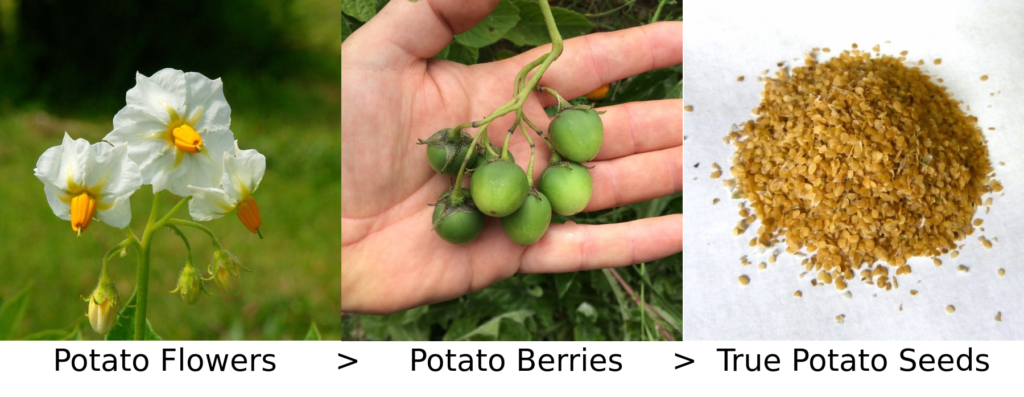 Why not just grow potatoes from true seed then? That’s the tricky part. Potato varieties are clones. When you plant a tuber of, say, Yukon Gold, you are really planting part of the same original plant that was first grown from true seed in the 1970s. Each generation of tubers is just more clones of that plant. Clones are predictable, which is a good thing for agriculture. True potato seeds, on the other hand, are the sexual progeny of the potato plant and, just like human children, each one is different. Every seed in every berry will produce a plant that is new and distinct from any other potato; it is a brand new variety with newly jumbled up genetics. That potato is unique to your garden. When you grow potatoes from TPS, you are breeding new varieties. Even if you are only growing out seeds produced by someone else, you get to choose which varieties to keep and which to discard, based upon what matters most to you. You can keep them and replant the tubers indefinitely. You can name them, share them, or even sell them if they are particularly good.
Why not just grow potatoes from true seed then? That’s the tricky part. Potato varieties are clones. When you plant a tuber of, say, Yukon Gold, you are really planting part of the same original plant that was first grown from true seed in the 1970s. Each generation of tubers is just more clones of that plant. Clones are predictable, which is a good thing for agriculture. True potato seeds, on the other hand, are the sexual progeny of the potato plant and, just like human children, each one is different. Every seed in every berry will produce a plant that is new and distinct from any other potato; it is a brand new variety with newly jumbled up genetics. That potato is unique to your garden. When you grow potatoes from TPS, you are breeding new varieties. Even if you are only growing out seeds produced by someone else, you get to choose which varieties to keep and which to discard, based upon what matters most to you. You can keep them and replant the tubers indefinitely. You can name them, share them, or even sell them if they are particularly good.
Seed Potatoes vs. True Potato Seeds
| Seed Potatoes | True Potato Seeds |
| Tubers are genetic clones of the parent plant | Seeds are genetically unique progeny |
| Results are predictable and uniform | Results are unpredictable and diverse |
| Tubers can be planted directly in the soil | Seeds are started indoors, similar to tomato |
| Tubers can carry a lot of diseases | Seeds carry few diseases |
| Tubers last about a year | Seeds can last 50 years in the freezer |
| Selection is limited, with less than 100 varieties available commercially | Selection is very wide, with access to many unusual types |
When you grow potatoes from true seeds, you will usually get a wide range of results. Some plants may produce nothing, while others can produce a tremendous yield. Most will be somewhere in the middle. Depending on what seeds you start with, you may get unusual colors and shapes that you would never find at the grocery store. Most of the seed potatoes that are available to gardeners are the same varieties that are used in large scale agriculture. They tend to be optimized for best production in potato growing regions and they have traits that best suit growers and processors, rather than consumers. If you live in potato country and you are totally happy with grocery store spuds, TPS might not be for you. You aren’t likely to get better varieties with commercial traits than the ones that already exist. On the other hand, if you are trying to grow potatoes in an area where the commercial varieties don’t do very well or you find grocery store spuds a little dull, TPS is probably just what you are looking for. Just have a look at the kinds of results that we get from our true potato seed mixes:
There is incredible depth to the potato. If you are looking for something that you can grow in your garden that will never show you the same thing twice, you would probably enjoy TPS. If you have only been exposed to grocery store potatoes, you have barely scratched the surface. TPS gives you access to a whole new dimension of flavors, colors, and textures available in Andean potatoes and there are also nearly 100 species of wild potatoes, many of which can be crossed with domesticated potatoes to introduce new traits. The process of growing potatoes from true seeds can seem intimidating, but if you can grow tomatoes from seed, you can grow potatoes from seed. There are some common mistakes to avoid when growing TPS, but once you get past those, growing potatoes from seed is easy. If you find it interesting, you can also get very deep into the technical details of potato breeding and learn more than you ever imagined. You could probably spend a lifetime exploring potatoes from TPS and never get bored. I could, anyway.
The easiest way to get started growing potatoes from TPS is to start from seeds. If you are in a favorable climate, you might be able to save seeds from potatoes that you already grow, but this is a bit tricky for most people. If you are lucky enough to already have a variety that makes berries for you, then you can follow any instructions for saving tomato seeds to extract them from the berries and clean them. The plants that you grow from TPS are much more likely to form berries than plants grown from commercially available seed tubers. Once you get started, you can easily save your own seeds and keep growing.
Start your seeds in flats or pots no more than eight weeks before your last frost. For most people, it would probably be best to start them four weeks before the last frost to keep from planting them out too early. Grow them under lights. Ambient light is not enough for potato seedlings. Keep the temperature between 50 and 70 degrees. Too hot or too cold and they will be slow to emerge. When the seedlings are about six inches tall, harden them off and then transplant outdoors, burying them up to the top set of leaves. You can make starting TPS more complicated than that, but for your first attempt, it should work just fine.
If you are ready to dig deeper, check out our Growing Guide for True Potato Seeds. You can buy many kinds of true potato seeds in our store. For absolute beginners, I recommend the Wide Tetraploid True Potato Seed Mix. If you are ambitious, there is a lot more available at our true potato seed page.

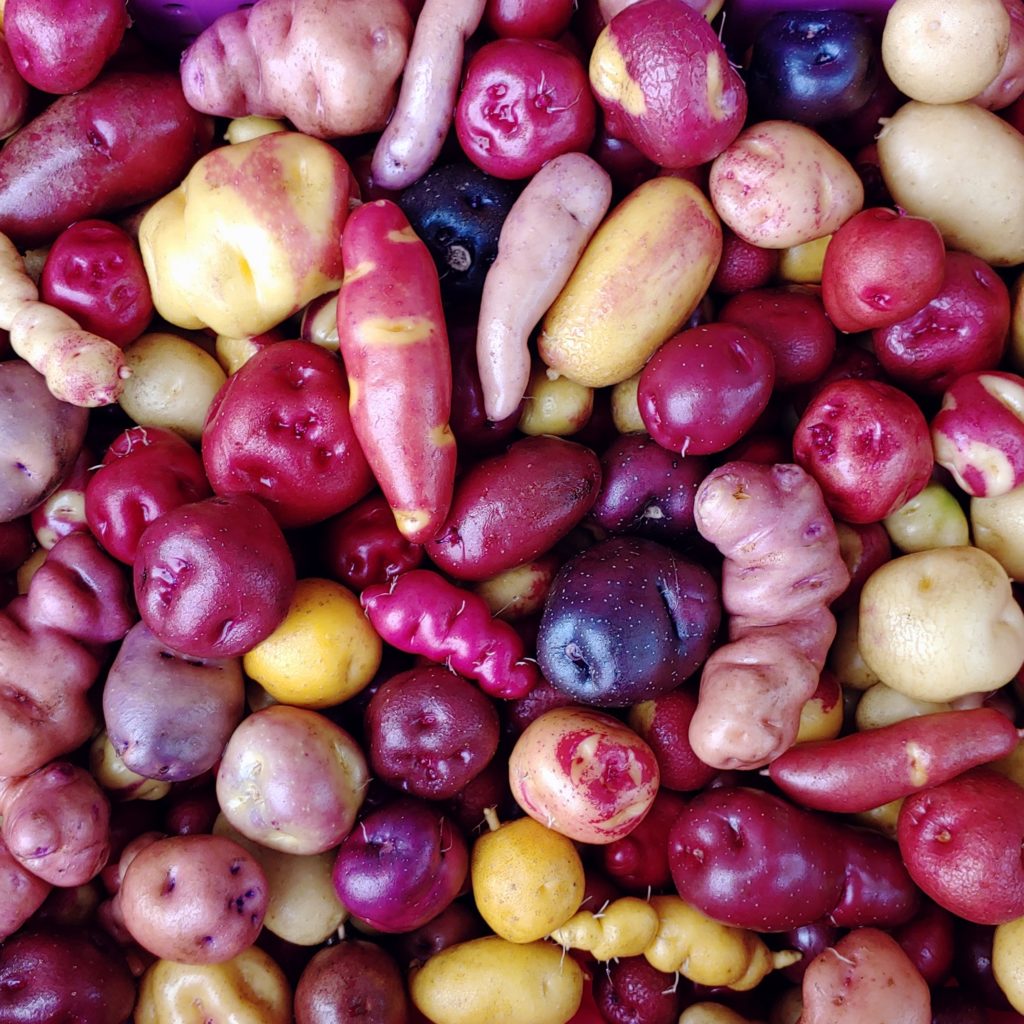
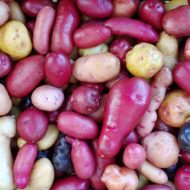
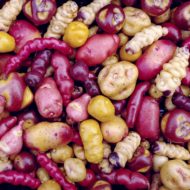
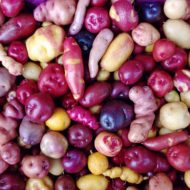
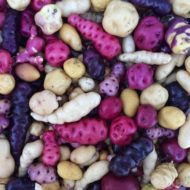
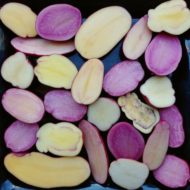
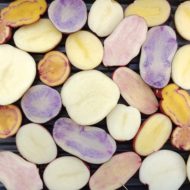
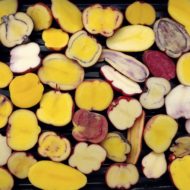
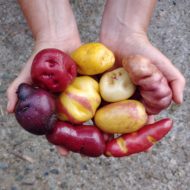
Fascinating. I had no idea.
How long should the berries stay on the potato plant after they’ve formed and when should they be harvested
The berries should be left on the plant at least six weeks. It is even better to leave them until they fall off on their own or can be removed with just a light touch, although they may be vulnerable to animal damage if you leave them that long.
I’m looking forward to trying to breed better potatoes for my zone (10b), Southern California. I’ve ordered low dormancy diploid seeds which I *think* might work out well here. Thank you for making these available! It will take some experimentation to figure out the optimal timing, since most calendars revolve around “frost dates”–not really an issue here–rather than day length. An exciting project!
It will be a different kind of potato and a different method of growing, but I think diploids could be a very interesting crop in your climate. Good luck!
I’m just curious as to know how long it takes to get a crop of potatoes from seeds
Generally, about six to eight weeks longer than it takes to grow a crop from tubers. It partly depends on whether the seedlings are derived from early or late maturity types.
I was searching this, it would be great to make it visible! Your seeds arrived well!
Zone 10b/11a (North New Zealand) and no frosts….could I sow these directly into the garden in the spring as days get longer?
Hi Piet. See here for more info: https://www.cultivariable.com/instructions/potatoes/how-to-grow-true-potato-seeds-tps/#directsowing
Do you have any ideas about what potatoes would set seed in North Carolina? We live on a mountain side a bit down from the apalachin trail we get snows and frosts. I am hoping to breed a sort of landracer mix to feed my family of potatoe lovers we would eat potatoes everyday if we had them. My son and husband even like raw in slices.
Take a look at the Wide Tetraploid Mix. That is always a good place to start for practical potatoes and it has high diversity, so you ought to find something that seeds in your climate. Given your higher elevation and consequently cooler nighttime temperatures, you might find that a lot of them flower. If you find that you get a lot of flowering from that mix, then you could probably explore other varieties with good results as well.
I am growing two varieties from seed this year. Cruza 148 and Loowit. It took me two attempts to get a good germination rate, but from what I’ve read on your website this is normal. I am not very good at this yet… My question is, how do you get your plants to consistently set fruit? I have about 20 plants and have had lots of flowers, but they seem to keep dropping off without setting fruit. I’ve tried pollinating with a q-tip like I sometimes do with my tomato plants, but that has not worked. Thanks!
Consistent fruit set is tricky. The biggest factor that stands in the way is climate. If your weather is over 80 degrees for long, berries will be hard to get. If your weather is cooler, then insufficient pollination is the most likely problem. Bumblebees are the only potato pollinator of significance. They do a specific kind of pollination called “buzz pollination.” They vibrate their wings very quickly while holding on to the anthers, which causes the pollen to be released. If you don’t have many bumblebees, you won’t get many fruits. You can hand pollinate, but you must recreate the buzz pollination. The most common tool for this job is an electric toothbrush. Hold a container under the flower and apply the toothbrush. If the variety produces pollen, you will see it stream out of the anther tips. Once you have collected some pollen, you can use the q tip to apply it to other flowers.
Hi Bill,
Great article thanks.
I having seedlings growing in my greenhouse from seeds I extracted from some berries I found beside my potato plants last year. I grew 2 early varieties of potatoes last year (in Ireland), orla and homeguard.
Will the new potato variety from the seedling be a mixture of the 2 varieties?
I can’t find any information about Orla, but according to the European Potato Database, Home Guard has traits consistent with pollen infertility (no or very rare berries): https://www.europotato.org/varieties/view/Home%20Guard
Based on that, my guess is that the most likely options are that the berries are either self-pollinated Orla or Home Guard pollinated by Orla. Self-pollination would be the more likely possibility. It is also always possible that neither variety is male fertile and you caught pollen from another variety growing nearby. Whatever the case, it will be an adventure. You can hone your potato observation skills trying to look for traits consistent with one parent or another.
That’s fascinating, I will watch out for the traits, fingers crossed they are taste like the Orla variety. Thanks for replying.
This is my fourth year growing potatoes from tubers but my first year that I ever had a potato plant produce berries from what I understand it’s very hard for potatoes to produce the berries because everything has to be like perfect such as the soil PH the temperature the watering schedule everything so I was really surprised when I had one variety produce three berries on one plant and another variety of produce one Berry on one plant I don’t know exactly what I did right or if it just happened to because I did have quite a few bumblebees I didn’t know about the bumblebees until I read your comments so I don’t know if I just got lucky with having a couple of bumblebees around at the time that my flowers were open but now it’s my potatoes are dying off I don’t know I had one year that I was slightly successful another year that I was moderately successful last year I was not successful at all and this year I thought it was doing really good but then they all started going like they’re dying I know I got flea Beatles And I don’t know how to deal with those cuz I don’t like to use chemicals but other than that I don’t know what I’ve done wrong to make all my plants start to die off already unless they’re just an early variety I can’t remember how many days to harvest it said I have to look it up but it just doesn’t seem like it’s late enough in the season for them to be dying off compared to the first two years that I grew either way some of my questions were answered I appreciate that and if I were to save the four berries that my plants produced what do I do how do I go about doing that I seen that you said wait for them to fall off on their own but once that happens what do I do do they is the whole Berry the seed or other seeds inside the berry
How does one go about harvesting the TPS from the berry?
I’m placing the berries in a glass jar of water for 3 days. The seeds should fall to the bottom. Pour off the fermenting waste. Throughly dry the seeds removing all moisture and store in cool, dark place. Should last if properly done for around 10 years.
how do you store the berries for next year’s planting?
Maggie
what pests will consume the berries?
I’ve had russets in the past go to seed and this year a purple variety pumped out a few dozen berries and thankfully I noticed today only three remaining berries were left I wanted to leave them till fall….but tossed the dice and pulled them . I might be shy on the recommended six week window..on plant.
thank you.
Slugs will certainly have a go at them. Once they are fully ripe, just about anything will eat them.